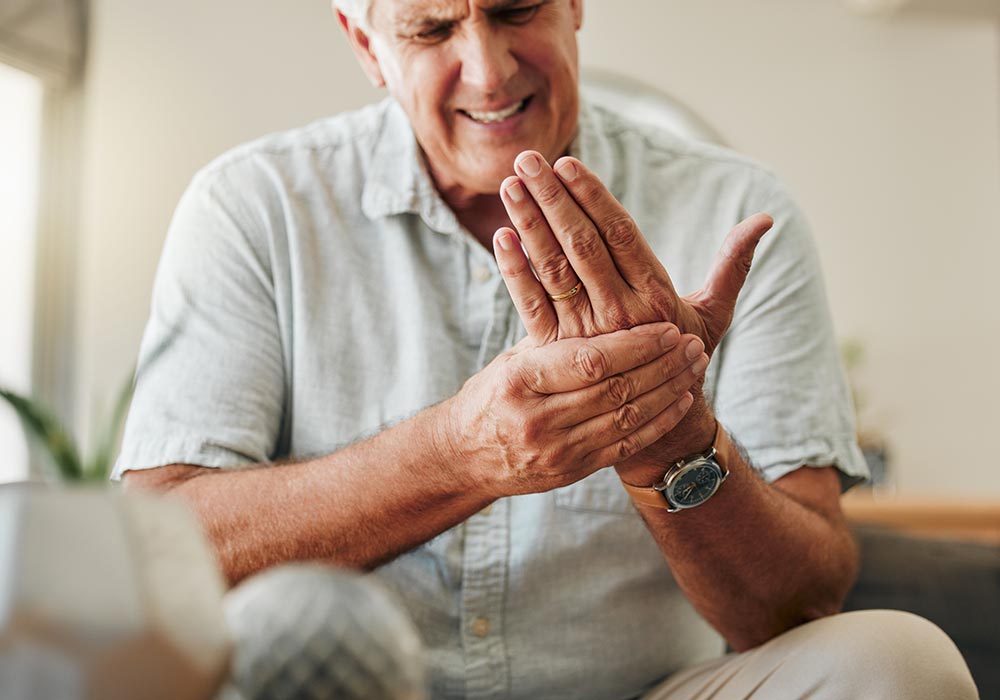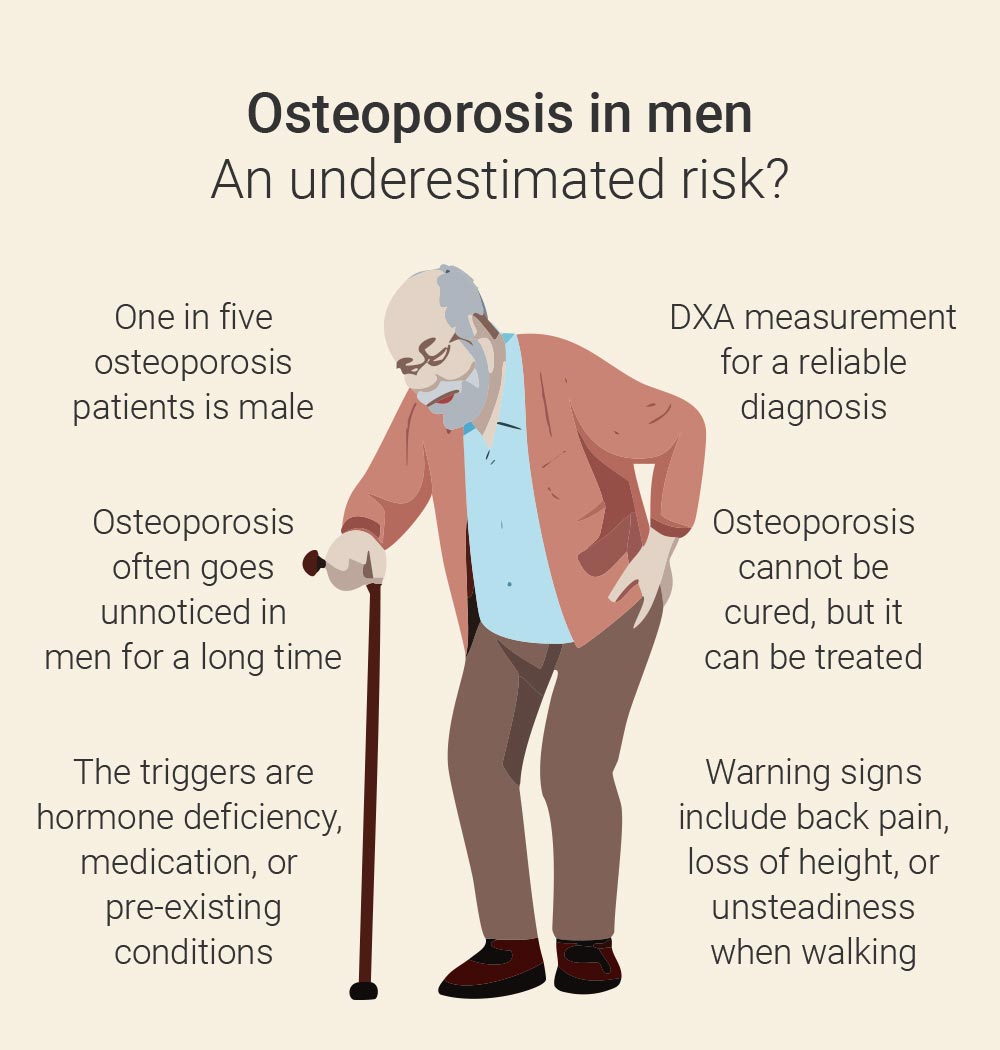Many people are unaware that men can develop osteoporosis during their lifetime. For a long time, bone loss was considered a typical women’s disease—a misconception that often leads to warning signs being overlooked or taken seriously only at a late stage. Yet early action can make a big difference and help maintain mobility and quality of life into old age. In this article, you will learn what exactly causes the disease, what men should look out for, and what is important in the event of a diagnosis.

What is osteoporosis?
Osteoporosis is a disease of the skeleton in which bone density decreases and the microarchitecture of the bone is damaged. As a result, the bones lose stability and become porous. They break more easily, even under everyday stress or minor falls.
Bones normally undergo constant remodeling: old bone substance is broken down and new bone substance is built up. In osteoporosis, bone breakdown predominates, while bone formation can no longer keep pace. The result is an increasing weakening of the entire skeletal system.
Osteoporosis in men: Bone loss can affect more than just women
Osteoporosis is often perceived as a typical women’s disease—and not without reason: Women’s risk increases significantly after menopause, as declining estrogen levels accelerate bone loss. The majority of diagnosed cases therefore do indeed affect women.
However, this one-sided view can easily lead to the disease being underestimated or even overlooked in men. In fact, about one in five osteoporosis patients is male (source: Nature Portfolio). The risk also increases significantly with age in men.
Unlike in women, the disease often progresses more slowly in men and is often only detected at a later stage. Therefore, men should also keep an eye on their bone health!

Osteoporosis in men: risk factors
Various circumstances can contribute to the development of bone loss in men. Risk factors for osteoporosis in men include:
A healthy hormone balance is crucial for maintaining bone density—even in men. The male sex hormone testosterone plays a particularly important role in bone metabolism: it supports the formation of new bone tissue and counteracts natural bone loss. A permanent drop in testosterone levels can significantly impair bone health.
Such a deficiency – medically referred to as hypogonadism – can occur due to age or be caused by diseases of the testicles, pituitary gland, or hypothalamus. Additional signs include fatigue, loss of libido, reduced muscle mass, or depressive moods.
In addition to disease-related hormone deficiency, medically targeted hormone suppression can also weaken bone substance: In men with prostate cancer, the body’s own testosterone production is often deliberately reduced as part of so-called androgen deprivation therapy in order to slow tumor growth. Although this form of therapy has a positive effect on the cancer, it can lead to a significant loss of bone density within just a few months.
It is therefore important for men undergoing hormone blockade to have their bone mass checked regularly – ideally accompanied by preventive measures against osteoporosis.
Some medications (especially when taken long-term or in high doses) can have a negative effect on bone metabolism and thus increase the risk of osteoporosis.
Of particular concern here are cortisone preparations, which are often used to treat chronic inflammatory diseases such as rheumatism, asthma, or Crohn’s disease. They inhibit bone formation and at the same time promote bone resorption.
Antiepileptic drugs, certain cancer drugs, and antidepressants can also disrupt calcium metabolism or influence hormonal processes that are important for bone health.
Another risk factor is the long-term use of proton pump inhibitors (PPIs), i.e., stomach protectors. These drugs can impair calcium absorption in the intestine, which can have a negative effect on bone density.
Regular review of medication is particularly important in the case of chronic diseases. Anyone who relies on such drugs should discuss with their doctor how the effects on their bones can be reduced.
Many men who develop osteoporosis have what is known as hypercalciuria. This means that the body excretes too much calcium in the urine, which can weaken the bones over time. According to estimates, this affects about one in ten men (source: Ärztezeitung).
If hypercalciuria is detected during diagnosis, calcium and vitamin D supplementation alone is often not sufficient. In these cases, it may be advisable to use a specific medication from the thiazide diuretic group. These reduce calcium excretion via the kidneys and can help stabilize bone density.
Important: Whether this treatment is suitable depends, among other things, on blood pressure. If blood pressure is generally low, treatment with bisphosphonates may be more appropriate. These medications slow down the breakdown of bone substance.
Furthermore, certain chronic underlying diseases can reduce bone health. This often occurs through indirect but long-term mechanisms.
For example, cirrhosis of the liver can disrupt vitamin D metabolism and thus impair calcium absorption in the intestine—an important building block for bone stability. The same applies to chronic kidney disease, where an imbalance in mineral metabolism can lead to bone loss.
Gastrointestinal diseases such as Crohn’s disease or celiac disease can also pose a risk: inflammatory processes or damage to the intestinal mucosa can reduce the absorption of important nutrients such as calcium, magnesium, or vitamin D. This can have long-term consequences for bone strength.
Another example is type 1 diabetes mellitus. In addition to blood vessels and nerves, this disease can also affect bone metabolism. Rheumatoid arthritis is also a risk factor, as it is associated with chronic inflammation and often with cortisone therapy. Both place additional strain on the skeletal system.
With these chronic diseases, it is particularly important to keep an eye on bone health. Regular check-ups and targeted prevention can help reduce the risk of osteoporosis and subsequent fractures.
Personal lifestyle also has an impact on the risk of osteoporosis in men.
Lack of exercise is one of the most common causes. Bones need regular stress to remain stable. People who do not get enough exercise—for example, due to sedentary jobs or physical inactivity in everyday life—risk a reduction in bone mass.
Excessive alcohol consumption and smoking also have a negative effect. Alcohol can disrupt bone metabolism, inhibit nutrient absorption, and impair hormone production. Nicotine, in turn, reduces blood flow to the bones and accelerates their breakdown.
Body weight also plays a role: being underweight is often associated with nutrient deficiencies and low mechanical stress. Both weaken the bones. Being severely overweight, on the other hand, puts strain on the joints and can promote inflammatory processes that can have negative consequences for bone health.
A conscious lifestyle with a balanced diet, regular exercise, and avoiding nicotine and excessive alcohol consumption is therefore an important contribution to the prevention of osteoporosis—especially in men.
From the age of 60, bone density decreases measurably and natural bone loss increasingly outweighs bone formation. In addition, there are age-related changes in hormone balance, a frequent reduction in physical activity, and an increased risk of deficiencies, such as vitamin D or calcium.
Another important risk factor is family predisposition. Those who have close relatives with osteoporosis are themselves at increased risk of being affected earlier or more severely. Genetic factors influence not only bone structure, but also the individual’s ability to absorb nutrients or regulate hormone balance.
Men with a family history of the disease or who are getting older should therefore pay particular attention to any changes and consider seeking medical advice in good time. Early detection is the key to limiting or completely avoiding further damage.
Osteoporosis in men: Watch out for these warning signs
The onset of bone loss often goes unnoticed. This makes it all the more important to recognize typical signs early on. The following signs may indicate impaired bone health in men:
- Sudden or chronic back pain with no apparent cause
- Decrease in height (more than 3 cm)
- Postural problems, e.g., hunched back or sunken chest
- Bone fractures from minor causes (e.g., lifting or tripping)
- Decreased muscle strength and physical weakness
- Increased falls or unsteady gait
- Loss of quality of life due to mobility restrictions
- Persistent exhaustion or general feeling of weakness
If one or more of these warning signs occur, a medical examination should be carried out – ideally including bone density measurement in our private practice for orthopedics & traumatology in Frankfurt. If detected early, the progression of the disease can usually be slowed down significantly.
Osteoporosis in men: DXA measurement as the gold standard for diagnosis
DXA measurement (dual energy X-ray absorptiometry) is an internationally recognized standard procedure for determining bone density. It is painless, takes only a few minutes, and causes only very low radiation exposure. For patients, the examination is comparable to a simple X-ray—but much more accurate when it comes to assessing bone stability.
Measurements are usually taken at the lumbar spine and thigh bones (more precisely: the femoral necks), as these regions are particularly frequently affected by osteoporosis-related changes. Up to the age of 70, the focus of the measurement is usually on the lumbar spine and the left femoral neck. From the age of 70, the right femoral neck is usually also measured in order to be able to assess age-related developments more accurately.
The result is reported as a T-score. This value shows how much your bone density deviates from that of a healthy young adult:
- A T-score between −1 and −2.5 indicates osteopenia (a precursor to osteoporosis).
- According to the World Health Organization (WHO), a T-score of −2.5 or lower is considered an indication of manifest osteoporosis.
In addition, a Z-score is often calculated, which evaluates bone density in comparison to people of the same age. This is particularly helpful in men under the age of 50 or in cases of unusual disease progression.
DXA measurement is not only suitable for initial diagnosis, but also for monitoring progress during ongoing therapy. It provides an objective basis for assessing the success of treatment and evaluating the individual risk of future bone fractures.
Osteoporosis in men: How treatment works
Osteoporosis cannot be cured, but it can be well controlled. Treatment depends on both the cause and the individual risk of fracture. With the right combination of lifestyle changes, medication, and regular checkups, the course of the disease can be positively influenced.
So, what can men do?
Basic measures
First, there are some general recommendations:
- A diet rich in calcium (1,000–1,200 mg/day)
- Vitamin D intake (800–1,000 IU/day, usually via supplements)
- Regular exercise, especially strength and balance training
- Avoid smoking and excessive alcohol consumption
Drug therapy
Medication is used in cases of increased fracture risk:
- Bisphosphonates: standard treatment for inhibiting bone loss
- Denosumab: alternative in cases of intolerance
- Testosterone: in cases of proven hormone deficiency
- Thiazides: in cases of increased calcium excretion in the urine (hypercalciuria)
Further measures
Important additions: fall prevention, regular bone density measurements, and monitoring of possible comorbidities.
Diagnosing and treating osteoporosis in men in Frankfurt
Bone loss in men is still often underestimated. Anyone who recognizes the first warning signs or belongs to a risk group should not hesitate to seek medical advice.
Our practice in Frankfurt is the ideal place to go. With modern diagnostics, many years of experience in the field of osteoporosis treatment, and a holistic view of possible causes, we are your experienced point of contact.
Whether for prevention, diagnosis, or therapy planning: we focus on your bone health and individually tailored care. Simply contact us to make an appointment!
534474304 © Kay Abrahams/peopleimages.com | 782244429 © Nandalal | stock.adobe.com